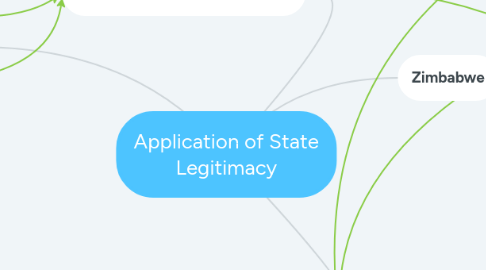
1. Kiribati
1.1. Government Structure
1.1.1. Parliaments and Monarchies work together; the government respects the monarchies and all laws have to pass through the kings before they can be brought up at parliament.
1.1.2. Use of Monarchies derives from ancient tribal traditions; the historical values of chiefs are upheld.
1.2. Economic Development
1.2.1. Foreign vessels have to pay for a fishing license, which increases economic growth.
1.2.1.1. Government puts observers on boats so as to remove corruption (they don't take more than they paid for).
1.2.2. Tourism built on cultural values: Foreigners pay tour guides to see how the government and monarchies work closely together.
1.2.2.1. This increases the revenue
1.2.2.2. Appeals to the core element of legitimacy coming from social norms
1.3. On-going Legitimacy
1.3.1. Limited use of media in Kiribati, so government uses radio, newspapers etc. Some censorship due to conservative culture - does not necessarily limit freedom of speech as social norms are upheld.
1.4. Issues
1.4.1. January 2018 Shipwreck led to 81 deaths and a crisis.
1.4.1.1. "Incompetence at every level"
1.4.1.2. Lead to citizens blaming the government for not doing safety checks.
2. INCREASE STATE LEGITIMACY
3. DECREASE STATE LEGITIMACY
4. Zimbabwe
4.1. Government Structure
4.1.1. One man (Mugabe) in power for the last 30 years gave the state legitimacy as that was the norm.
4.1.1.1. Mugabe's wife Grace received her PhD after only a few months of study, while Mugabe was university chancellor.
4.1.2. Unjust and unfair elections, violent repercussions against outspoken opposition members, government sanctioned DPRK-trained massacres etc. led to legitimization by force.
4.1.2.1. However, the attempted removal of the vice-president (who had the army by his side) to put Grace Mugabe in power led to widespread opposition and the peaceful revolution/coup of November 2017.
4.2. Economic Collapse
4.2.1. Economy was prosperous before, in the early years however has been full of corruption, inflation etc.
4.2.1.1. 2008 HyperInflation, leads to international companies withdrawing from ZImbabwe and economy to start collapsing.
4.2.1.2. 2018 Hyperinflation again, no dollars, Zimbabwe bond note which is meant to be 1:1, is traded on the black market for as much as 10:1.
4.2.1.3. Years of corruption and money laundering by the government means that banks have no money to provide to businesses, thus preventing the importation of products, increasing taxes.
4.2.1.3.1. Currently implementation of 2% tax on internal electronic financial transactions being debated.
4.2.2. Destruction of the agricultural sector has led to the termination of certain domestic crops being produced.
4.2.2.1. Land and industrial farms taken away from White Farmers in 90's and given to government officials is inefficiently used, decreasing agricultural production.
4.2.2.2. Land given to uncultured producers is inefficiently (or not at all) used and conditions are not suitable for all crops.
4.3. Social Well-being
4.3.1. Education
4.3.1.1. In early years of Mugabe's rule, everybody had access to education, thus leading to an educated, literate population.
4.3.1.2. These policies however have degraded over time and education is not provided to everybody anymore. The education of parliament/government members can also be contested...
4.3.2. Health services, public transport and other social well-being services are despicable and practically non-existent.
4.3.2.1. All of these factors combined to decrease the State's legitimacy so much, that it eventually led to the revolution.

